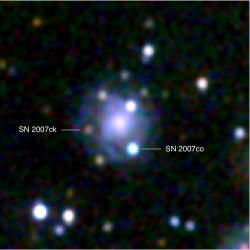Supernovae are rare events, only occurring once every 25-100 years in galaxy. So it came as a complete surprise when NASA’s Swift satellite turned up two supernovae going off at the same time in a galaxy – separated by only 16 days.
Until now, astronomers have never seen a supernova going off in the galaxy MCG +05-43-16, and then suddenly: kaboom kaboom. The twin supernovae have been categorized SN 2007ck and SN 2007co.
And they’re completely different events. The first, SN 2007ck, is a Type II supernova, where a star with many times the mass of our own Sun runs out of fuel and collapses catastrophically. This creates a black hole or neutron star, and blows the outer layers of the star into space.
The second, SN 2007co is a Type Ia event. This is where a white dwarf star steals material from a binary partner until it can’t hold any more material, and detonates in a massive blast.
This is a complete coincidence. The two events are separated by tens of thousands of light years of space. In fact, an astronomer in the galaxy might see the two events separated by thousands of years.
Original Source: NASA

